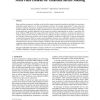Free Online Productivity Tools
i2Speak
i2Symbol
i2OCR
iTex2Img
iWeb2Print
iWeb2Shot
i2Type
iPdf2Split
iPdf2Merge
i2Bopomofo
i2Arabic
i2Style
i2Image
i2PDF
iLatex2Rtf
Sci2ools
CGF
2010
2010
Mixed Finite Elements for Variational Surface Modeling
Many problems in geometric modeling can be described using variational formulations that define the smoothness of the shape and its behavior w.r.t. the posed modeling constraints. For example, high-quality C2 surfaces that obey boundary conditions on positions, tangents and curvatures can be conveniently defined as solutions of high-order geometric PDEs; the advantage of such a formulation is its conceptual representation-independence. In practice, solving high-order problems efficiently and accurately for surfaces approximated by meshes is notoriously difficult. Classical FEM approaches require high-order elements which are complex to construct and expensive to compute. Recent discrete geometric schemes are more efficient, but their convergence properties are hard to analyze, and they often lack a systematic way to impose boundary conditions. In this paper, we present an approach to discretizing common PDEs on meshes using mixed finite elements, where additional variables for the der...
| Added | 09 Dec 2010 |
| Updated | 09 Dec 2010 |
| Type | Journal |
| Year | 2010 |
| Where | CGF |
| Authors | Alec Jacobson, Elif Tosun, Olga Sorkine, Denis Zorin |
Comments (0)

